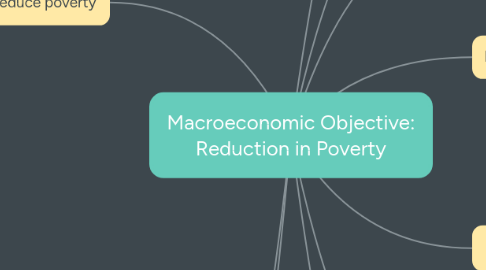
1. Supply-side Policy
1.1. Government attempts to increase productivity and increase efficiency in the economy
1.2. Free-market supply-side policies
1.2.1. policies to increase competitiveness and free-market efficiency. For example, privatisation, deregulation, lower income tax rates, and reduced power of trade unions.
1.3. Interventionist supply-side policies
1.3.1. government intervention to overcome market failure. For example, higher government spending on transport, education and communication.
1.4. Manipulations by the government of its own expenditures and taxes to influence the level of aggregate demand
2. Geography
3. An income level that is considered minimally sufficient to sustain a family in terms of food, housing clothing, medical needs
4. Definition
4.1. Government policies
4.1.1. Monetary Policies
4.1.1.1. The use of the interest rates (via manipulating the money supply) to influence aggregate demand
4.1.2. Fiscal Policy
4.2. Poverty Line
5. Causes of Poverty
5.1. Low incomes
5.2. Unemployment
5.3. Low levels of human capital
5.4. Discrimination
5.5. Low Living Standards
5.6. Age
5.7. Poverty
6. Types of Poverty
6.1. Absolute Poverty
6.1.1. When a household's income is below the poverty line (doesn't meet basic human needs)
6.2. Relative Poverty
6.2.1. A concept that compares the income of individuals/households in a society with median incomes
6.3. Low levels of capital/land ownership
7. Consequences
7.1. Lack of access to health care & education
7.2. Limited social services (merit goods)
7.3. Higher infant, child & maternal mortality
7.4. Higher levels of preventable diseases
7.5. Social Problems
7.6. Inability to realize one's full potential
8. Policies to reduce poverty
8.1. Supply side policies
8.1.1. Deregulation
8.1.1.1. Allowed the financial system to take much greater risks than they would have done under effective supervision
8.1.2. Lower unemployment
8.1.3. Reduce the power of trade unions
8.1.4. Make labour markets more flexible
8.1.4.1. Depressed wages
8.1.4.1.1. Workers have less power to use collective bargaining power to protect their wages & working condition
8.1.5. Standard employment
8.1.5.1. Has a permanent & secure contract to work full-time
8.1.6. Non-standard employment
8.1.6.1. Temporary workers/part-time workers, workers on zero hours contracts and self-employed workers
8.1.6.1.1. Less security & lower incomes
8.1.6.2. Risks
8.1.6.2.1. Lack of job security
8.1.6.2.2. Lower average earnings
8.1.6.2.3. uncertain working hours
8.1.6.2.4. Concerns over health and safety of workers
8.1.6.2.5. Inability to access social security benefits (unemployment insurance/pensions)
8.2. Fiscal policies
8.2.1. Direct tax
8.2.1.1. Taxes paid directly to the government tax authorities by the taxpayer
8.2.1.2. Social security contributions/payroll taxes
8.2.1.2.1. These taxes are paid by workers and their employers
8.2.1.2.2. The revenue from these taxes are used to finance specific expenditures
8.2.1.2.3. Ex. pensions, social insurance, and health care
8.2.2. Indirect tax
8.2.2.1. Taxes on spending on goods & services
8.2.2.2. General expenditure taxes (sales taxes)
8.2.2.2.1. Taxes on spending/sales of goods & services
8.2.2.2.2. Excise taxes
8.2.2.2.3. Custom duties (tariffs)
8.2.3. Transfer payments
8.2.3.1. Benefits paid for which no goods and services are received in return, such as unemployment benefits and pensions.
8.2.3.2. Improve living standards and opportunities
8.2.3.3. Child support, maternity & paternity benefits, old age pensions, etc.
8.2.4. Disadvantage
8.2.4.1. Political influence
8.2.4.1.1. where the government expenditure goes and taxes can be used by politicians for electoral purposes
8.2.4.2. “Crowding out”
8.2.4.2.1. governments borrow to increase their expenditure and offer a high interest rate on their bonds.
8.2.4.2.2. Private sector, in order to compete with the government, increases its interest rate, thus discouraging private investment.
8.2.4.3. If taxes are decreased, people might start saving the extra income and the expansionary fiscal policy does not work (or its effect is smaller).
9. Measures of poverty
9.1. Minimum income Standards (MIS)
9.1.1. Ongoing research on what people in a population believe are the essentials for a minimum acceptable standard of living that allows people to participate in society
9.2. Multidimensional Poverty Index (MPI)
9.2.1. Measures in the areas of health, education, and standard of living
